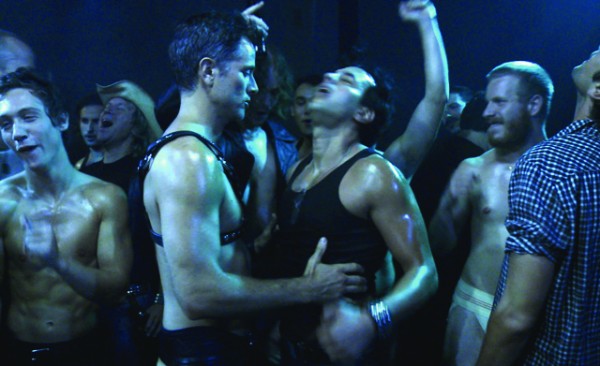Filmmakers James Franco and Travis Mathews collaborate to reimagine the 40 minutes of explicit footage that was cut from Cruising, William Friedkin’s controversial 1980 film to appease the ratings board and avoid an X rating. A cause célèbre in its time and a time capsule of a long-gone, pre-AIDS era, Cruising starred Al Pacino as an undercover detective immersed in New York’s gay leather bars to catch a serial killer.
Interior. Leather Bar is hard to define: part documentary and part fiction, docudrama or constructed reality. It opens as a behind-the-scenes featurette, with Franco and Mathews discussing the motivations for the project, before casting and assembling their crew in a cramped black box theater in Los Angeles for a two-day shoot.
Much to the disappointment of some of the infatuated actors gathered, Franco stays behind the camera, keeping his clothes on and his acting talent under wraps. He instead casts for the lead Val Lauren, who reluctantly accepts a role as a favor to Franco. Lauren, a married, straight friend, fellow Playhouse West cohort, and star of Franco’s directorial debut, Sal, plays Pacino-as-the-detective, whose involvement in the gay scene in Cruising challenges his sexuality.
For his part, Lauren’s coming to terms with his gay-themed role and his quest to understand the project becomes central to the film. His discomfort is palpable. While unsimulated gay sex is performed around him, Lauren is forced to rethink his boundaries. He awkwardly questions other actors about their own sexuality and the lines they’d cross in a performance, when he’s not fielding calls from his teasing but supportive wife and an aggressive homophobic friend/agent (improvised by one of Franco’s producers).
Franco has been the subject of speculation about his sexuality as a consequence of some of his art projects and the homoerotic overtones of some of his films, and he only ventures near the camera to watch performances or talk about the movie with Lauren or Mathews. Mathews attempts to shift the attention onto Franco’s creative process while Lauren exposes their friendship. In conversation with Franco, Lauren expresses his own anxieties, questions the very reason why Franco is making this film and expresses his concern about the negative impact on Franco’s reputation.
While Cruising is a starting point for Interior. Leather Bar, the new film misrepresents itself as the reimagining of the lost 40 minutes. Franco and Mathew’s 40 minutes don’t exist either on account that only a fraction of this footage is spliced into this “documentary.” The film shies away from real hardcore activity and instead portrays barroom blow jobs and some spanking while Lauren and Franco’s watch.
It’s impossible to tell how much is “real” and how much is prescripted. The directorial play includes a scene when, crouched in the parking lot, Val reads his script out loud, including the direction to sit and read the script out loud. This, along with the fictional homophobic telephone calls and multiple view points as cameras switch from the reimagined footage to production footage to footage of the production being documented, lends another layer to the film.
Interior. Leather Bar defies easy categorization. Mathews states that he and Franco “shared a concern that the race toward equality, with gay marriage, was also a race of straightening out the queer kinks, of erasing subcultures in favor of assimilation.” Franco expresses his frustrations with Hollywood’s almost exclusive heterocentric indoctrination of audiences that provokes disquiet when they are presented with gay sexuality in mainstream cinema. The project is as much about filmmaking as it is an exploration of sex, creativity, trust, and boundaries. A fascinating, frustrating, and thought-provoking film that leaves you wanting your full “40 minutes.”







Leave A Comment